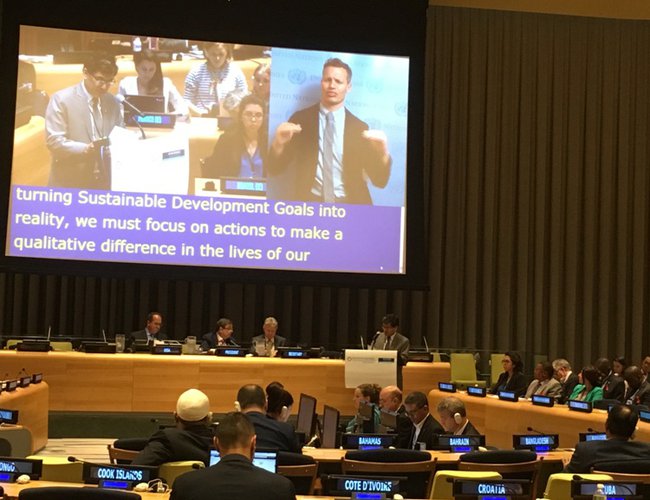
On 18 July 2017, the Vice Chairman of the NPC and head of the Nepali delegation, Min Bahadur Shrestha, presented Nepal’s national statement at the Plenary Meeting of the 2017 High-Level Political Forum held at the UN Headquarters in New York. He drew attention to the new Constitution and the re-structuring of the state, to the local elections currently being held, and argued that, despite certain constraints, ‘Nepal is mustering all strength and putting in relentless efforts in the hope of achieving the SDGs’, adding that it was Nepal’s intention to build on its achievements as regards the MDGs and focus fully on realizing the SDGs by 2030. He explained that Nepal was already planning to adopt initiatives to mainstream and localize SDGs into its national plans and programmes. He said that he anticipated a growth rate of 7 per cent in Nepal’s GDP for the year 2016-17.
He did refer to the constraints that still existed, including not only natural disasters, like the sudden shocks of the 2015 earthquakes which destroyed 500,000 homes and many thousands of other buildings both private and public, and the longer term processes associated with climate change, but also Nepal’s institutional weaknesses, affecting its capacity to implement its plans and policies, and its technological, infrastructural and other resource gaps. He called for generous assistance from Nepal’s international partners to overcome these weaknesses and constraints to help create an enabling environment for LDCs like Nepal to fully realize their potential, as agreed in the Istanbul and Vienna Programmes of Action.
He did not, however, refer to the political infighting between the leadership of the three major political parties which has led to the marginalisation of other political interests – notably those representing the people of the Terai or Madhes - has failed to resolve deep-seated regional political divisions (between ‘Paharis’ and ‘Madhesis’) and has generated a succession of short-lived coalition governments which have failed to address the major economic and social issues facing the country. He did not refer to the fact that attempts to manage these deep-seated divisions are why the first local elections for 20 years are being held in three separate phases, with the most crucial, affecting the most controversial of the new ‘provinces’ carved out arbitrarily as part of state re-structuring and the damaging commitment to ’federalism’, not being held until September 2017.
He did not refer to the fact that Nepal’s economy still relies heavily on rain-fed agriculture - despite its decline over recent decades to below 30 per cent of GDP, due to the failure to develop an adequate infrastructure for irrigation (which has meant only 40 per cent of the arable area in the eastern region being planted to rice this year) and, in the absence of any growth in the tiny industrial sector (less than 10 per cent of GDP), on services and on remittances sent back by Nepali migrant workers from abroad (which now account for roughly 30 per cent each of GDP).
He did not draw attention to the massive and rapidly increasing trade deficit, with imports accounting for 93 per cent of overall trade and exports for only 7 per cent, because of Nepal’s reliance on imports of fuel, raw materials for construction, vehicles and luxury consumer durables, and its failure to produce goods for export that are able to compete with Indian products or reach other markets, given Indian dominance in Nepal’s trade and its imposition of punishing taxes and transit fees on Nepal exports. He also did not mention the fact that from 1 July 2017, India proposes to introduce a new goods and services tax (GST), which will not affect goods coming from India to Nepal as the tax slab rate on such goods is zero, but is likely to increase the existing taxes and levies on Nepali exports to India and also Nepal’s third-country trade, if a tax is imposed on transport services.
He did not mention Nepal’s failure to realize more than a tiny proportion of its massive hydro-power potential and its continued reliance on imported electricity and other sources of power and fuel, its poor transport infrastructure even as regards links with India, its major trading partner; its failure to extend electricity across the country, so that rural development becomes possible; and its failure to develop its IT and other new technologies, remaining reliant again on imports of such technologies largely as luxury consumer items for the urban ‘middle classes’.
He did not mention the poor record of Nepal in attracting foreign direct investment (FDI) and the fact that it declined in the first half of 2016-2017 to Rs 1.3 bn in comparison with Rs 3.7 bn in the same period the previous year. He did, however, allude to the lack of investment I general, and called upon the ‘international community’ to do more to provide ‘aid’ and assistance in this regard. But he failed to mention the persistent failure by the state, year on year, to spend its capital budget effectively on economic and social development; and the tendency of the private sector, including the banks, to lend not to productive enterprises but to speculative land development for real estate and for construction in the hotel, restaurant and entertainment sector. He also did not mention the difficulty that most small businesses experience in gaining access to loans at reasonable interest rates, particularly in the agricultural sector, which is (quite rightly) regarded as ‘high risk’, or the relatively un-attractive interest rates for deposit and savings accounts.
Three major developments of some significance, not only in terms of Nepal’s development but also in terms of regional geo-politics, were also, however, not mentioned. The first of these was that the USA and the government of Nepal are apparently ‘all set’ to sign a Millennium Challenge Corporation (MCC) five-year investment compact worth $630 million – the largest ever US investment grant assistance package for Nepal – in September 2017; $500 million of this would be a grant. This would be largely for the development of the power and transportation sectors, where investment is badly needed. The bulk of the grant would go to the Electricity Transmission Project (ETP) with the remainder being allocated to the Road Maintenance Project (RMP). The second – which effectively dwarfs the first - is Nepal’s official involvement, since 12 May 2017, as a founding partner (albeit a very small one) in China’s enormous Belt and Road Initiative (BRI) - which has already committed investment of more than $1 trillion to develop infrastructure across Asia.
There can be no doubt that Nepal’s economic future, in the short term as well as in the long term will depend in large part on how well it manages its relationship with China on the one hand and India on the other. A recent feasibility study of a proposal for a Free Trade Agreement (FTA) with China warned of the dangers of harnessing Nepal’s weak economy to that of yet another giant neighbour. Already, Nepal’s trade deficit with China is substantial with figures from the last fiscal year suggesting that, while imports from China were worth about Rs 117 bn, exports were worth less than Rs 2 bn. Nepal has made it clear that it could not afford to go ahead without a commitment on China’s part to invest in Nepal’s infrastructure and production base. All of the evidence, however, suggests that closer integration with China will antagonize Nepal’s major trading partner, India, and will also serve to further subordinate the dynamics of Nepal’s political economy to the interests of its two giant neighbours.
Once again, as was the case two and a half centuries ago, in the words of Prithivi Narayan Shah, Nepal is but ‘a yam between two boulders’ and its prospects of moving from its current status as one of the world’s LDC and of achieving its SDGs are, to say the least, more challenging than the recent presentation to the UN by Min Bahadur Shrestha suggested.

David Seddon
Seddon is a development analyst with a long involvement in Nepal. He is co-author, among other works, of Nepal in Crisis: growth and stagnation at the periphery, and has contributed previously to New Spotlight.
- The (Poor) State Of Nepal’s Economy – Re-Visited
- Jan 27, 2019
- The (Poor) State of the Economy – Re-Visited
- Jan 07, 2018















